Elections in Narendrabhai Damodardas Modi’s Bharat Hindutva: A Lesson in the Transformation of Democracy in Religious Autocracy (Part 2)
TRANSCEND MEMBERS, 15 Apr 2024
Prof Hoosen Vawda – TRANSCEND Media Service
This paper is written as an objective analysis of the current political climate in India, prior to the general election, being the largest democracy in the world. Readers are invited to discuss any statements, perceived as biased and prejudiced, with the author.
****************************
“The Contest: The upcoming Indian general election is a high-stakes battle between Prime Minister Narendra Modi’s Bharatiya Janata Party (BJP) and a coalition of over a dozen opposition parties, including the Indian National Congress. Modi, who first came to power in 2014, is seeking a third consecutive term. His campaign centers not only around an economic reform, but more importantly, a Hindu nationalist agenda. If Modi wins again, he will match the record set by India’s first prime minister, Jawaharlal Nehru [1], for three consecutive terms.
“The Process: India’s election follows a multiparty parliamentary system. Voters will cast their ballots in seven sequential phases, with results announced on June 4. The winning party or coalition, securing at least 272 seats, will form the government and nominate the prime minister. The BJP’s campaign emphasizes Modi’s leadership, while the opposition aims to unseat him. As the world’s largest democratic exercise, this election not only shape India’s political landscape, but also the global political scenario.” [2]
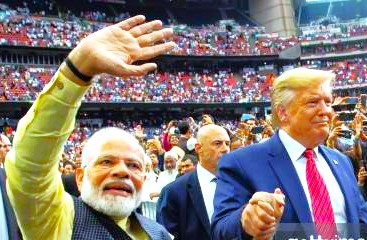
The Popularity of Prime Minister Narendra Modi in the Indian Diaspora in United States.
Trump welcomed Modi to the U.S. in September 2019, the two men attending the “Howdy Modi” event in Houston, Texas and walking around the packed NRG stadium hand in hand and waving to the crowds. Trump praised Modi as one of America’s “greatest, most devoted and most loyal friends,” while Modi said India had a “true friend” in the White House. “He has left a lasting impact everywhere,” Modi said of Trump, who he described as “warm, friendly, accessible, energetic and full of wit.”
In reciprocation, President Donal Trump kicked off a 36-hour trip to India, with a visit to the former home of independence leader Mohandas Gandhi, before heading to a rally in Sardar Patel Stadium in Ahmedabad in India, More than 100,000 people filled the world’s largest cricket stadium, which is also known as Motera Stadium, as almost everyone in attendance donned a white cap with the name of the event “Namaste, Trump” (“Welcome, Trump”) written on it, the Associated Press reported.
Photo Credit Saul Loeb Getty Images
This publication, Part 2, in a series to coincide with the forthcoming General Elections in India, discusses the popularity of Prime Minister Modi. The General elections will be held in India from 19 April 2024 to 1 June 2024 to elect the 543 members of the 18th Lok Sabha.[3] The elections will be held in seven phases and the results will be announced on 4 June 2024. Narendra Modi has been the 14th Prime Minister of India since 2014 and remains a very prominent and polarising political figure during his time in office. His ratings and popularity tended to vary based on different factors and contexts. Among his supporters from the BJP party and Hindu nationalist base, Modi enjoyed very high approval levels, often in the 70-80% range in many polls and surveys. They appreciated his image of a strong leader, his emphasis on Hindu cultural values, and his economic development agenda. However, Modi also faced substantial criticism from opposition parties and segments of the population uncomfortable with his Hindu nationalist leanings and some of his government’s policies on issues like freedom of speech, treatment of minorities, and human rights matters. At the national level, his overall approval numbers in 2022-2023 hovered around 50-60% in many polls, which while healthy, did show some decline from his first term when his ratings were higher in the mid-60s. Economic issues like unemployment and inflation appeared to be a drag on his popularity to some extent. It is worth noting that polling can vary substantially based on sample, methodology and other factors. But in general, Modi remained a very influential and consequential figure in Indian politics who inspired both vehement support and opposition from different constituencies.
Transformation of Democracy to Religious Autocracy in India Causing Communal Peace Disturbance
India, a diverse and vibrant nation, has a rich history of democratic governance. However, recent developments have sparked debates about the trajectory of Indian democracy. The phrase “transformation of democracy to religious autocracy” encapsulates these concerns.
Contextual Analysis:
Historical Perspective:
- Indian democracy emerged in 1950, following independence from British colonial rule. The Constitution of India, adopted in 1949, enshrined democratic principles, including free elections, civil liberties, and separation of powers.
- Maharaja Ganga Singh of Bikaner, even before the limited franchise became a reality, recognized the inevitability of democracy in India due to factors like Western education, unity among diverse communities, and Indians assuming high offices of state [4].
- The founding figures of Indian democracy understood the need for some level of authoritarianism within the constitutional framework to establish the nascent republic [5].
Recent Trends:
- Since 2014, when Narendra Modi assumed power, India has witnessed significant political shifts.
- Critics argue that India is drifting toward “electoral autocracy,” with erosion of democratic credentials. Reports from institutions like the V-Dem Institute have downgraded India’s democratic status [6].
- The period between 1989 and 2014 (the coalition era) often serves as a backdrop for discussions on India’s democratic deficit.
Religious Dimension:
- Religious practice is deeply ingrained in Indian society. Surveys indicate that religious individuals tend to believe in democracy more than non-religious ones.
- India’s democracy rests, to some extent, on the foundation of religious practice. In a hierarchical society, religious and electoral practices serve as the primary “public spheres” where social interactions occur [7].
Challenges and Concerns:
The transformation from a robust democracy to a religiously influenced autocracy raises several issues:
- Communal Peace Disturbance: As religious identity becomes more prominent in politics, communal tensions escalate. Clashes between different religious groups disrupt peace and harmony.
- Erosion of Secularism: The delicate balance between secularism and religious pluralism is at risk. Policies favouring one religion over others can undermine the secular fabric of the nation.
- Threats to Civil Liberties: Autocratic tendencies may curtail freedom of expression, dissent, and minority rights.
- Democratic Backsliding: The gradual erosion of democratic norms and institutions challenges the very essence of Indian democracy.
The transformation of Indian democracy into a religiously influenced autocracy is a multifaceted phenomenon. It demands critical analysis, public discourse, and vigilant efforts to safeguard democratic values while respecting religious diversity.
Hindu Support for Modi:
Prime Minister Modi came up in an arduous manner from the ranks of the disadvantaged, over decades. He is a brilliant strategist and a pious polymath, demonstrating his multiple innate attributes and qualities from a politician to a fully-fledged Hindu priest, well versed in Vedantic teachings, and practise as eloquently demonstrated during the consecration of the new Ram Mandir in Ayodhya, [8] as well as the BAPS Hindu Temple[9] in Abu Dhabi, UAE, an Islamic country. He has further placed individuals within the BJP, in key positions, each with their own branding and expertise, such as Yogi Adityanath[10], the Chief Minister and probably Modi’s successor. Yogi being a Hindu monk, turned a politician, has brought in the aspect of Hindutva into India’s political scenario, using his expertise to garner support of the majority Hindus in elections since 2014. In addition, he has a Muslim lady Shazia Ilmi, born 1970,[11] is an Indian politician and the national spokesperson of the Bharatiya Janata Party since July 2021[12], to ensure an apparent voice for the Muslim minority in India. He has also transformed the media in India, from the print, as well as the social and visual media, to an organ of total support for BJP in a do or die policy. His charismatic and charming personality has resulted in the masses identifying with him. He is also on an anti-corruption crusade across India, and especially where members of the opposition parties are holding key positions in different states, Modi has even had them arrested. He is also using the massive influence Bollywood firm stars[13] have on the masses and using them as candidates in different, appropriate scenarios. Furthermore, realising the value of mass mobilisation, he has influenced the production of several current big budget Bollywood movies in support of Modi and pro BJP, swaying the voters.[14] Practically, his supreme diplomatic skills in international politics, including the War on Gaza[15], has seen him playing both sides of the coin. He does not want to displease the “Master of the System”, yet he espouses freedom. Indeed, a clever, astute, calculated brain, in global politics. However, the popularity of Prime Minister Narendra Modi among non-Hindus in India varies significantly based on regional and cultural factors, even in the prelude to the 2024 elections:
- In the 2019 parliamentary election, approximately 49% of Hindu voters supported the Bharatiya Janata Party (BJP), which allowed the party to secure a majority in the Lok Sabha (India’s lower house of parliament) and granted Prime Minister Modi a second term in office[16].
- The BJP received high vote shares among Hindus in the Northern (68%) and Central (65%) regions, which include Delhi and Uttar Pradesh, respectively.
- However, in the East and South regions, the BJP’s support among Hindus was lower, with 46% in the East and a mere 19% in the South.
- In the South, significant shares of Hindu voters (20%) expressed support for the Indian National Congress (INC), which has led the country for most of the years since independence. Regional parties also garnered votes among Southern Hindus [17].
Regional Differences and Attitudes:
- Southern states tend to have higher per capita income and faster economic growth than most Northern and Central states.
- Hindu nationalist sentiments appear to have a smaller foothold in the South.
- While 64% of Hindus in India overall consider being Hindu as very important to their Indian identity, this share drops to 42% in the South.
- Similarly, the importance of the Hindi language to national identity is higher in the Central and Northern regions (87% and 71%, respectively) compared to the South (27%). Hindi is more widespread in the North and Central parts of the country but less common in the South [18].
Overall Perception:
- PM Modi continues to be highly popular among the Hindu community, with a mean score of 3.13 out of 4.
- Among non-Hindus (including Muslims and other minorities), the mean score for PM Modi’s performance is lower, standing at 2.33[19].
In summary, while Modi enjoys significant support among Hindus, his popularity among non-Hindus varies based on regional, linguistic, and cultural factors. These differences shape voting patterns and attitudes across India.
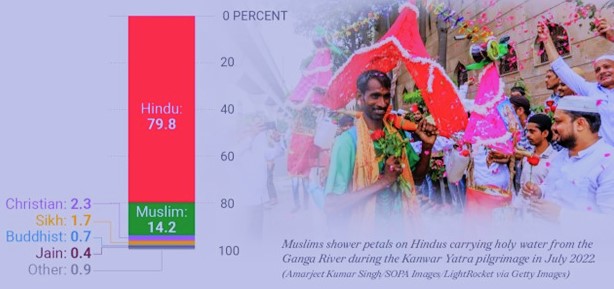
India’s Religious Diversity at a Glance. Since the BJP took power in 2014, many religious minorities face discrimination, persecutions, loss of religious freedom and removal from the citizenship register, based on religion. India is also a religiously diverse country. While Hindus comprise most of the India’s population (79.8%), there is a significant Muslim minority population (14.2%). Christians and Sikhs account for 2.3% and 1.7% of the Indian population respectively, with Buddhists, Jains and others making up the remaining 2%. Being the largest democracy in the world, India is often viewed as a role model for other heterogeneous countries trying to transition to democracy. Yet India’s own democracy remains fraught. The communal tensions that continue to undermine it have their roots in the traumatic process of partition from 75 years ago. The hastily administered bifurcation of the Indian subcontinent by its British colonizers was accompanied by the forced displacement of Muslims in Hindu-dominated areas to what had become Pakistan. Similarly, most Hindus settled in Muslim-majority regions were displaced to the newly created state of India. This mass migration was marred by rampant bloodshed, leading to between 1 million and 2 million deaths. While many Muslims shifted to Pakistan, a significant proportion of them stayed in India. Despite efforts made by the newly created Indian state to protect its minorities, Indian Muslims, along with other religious and ethnic minorities, have experienced recurrent discrimination and violence.
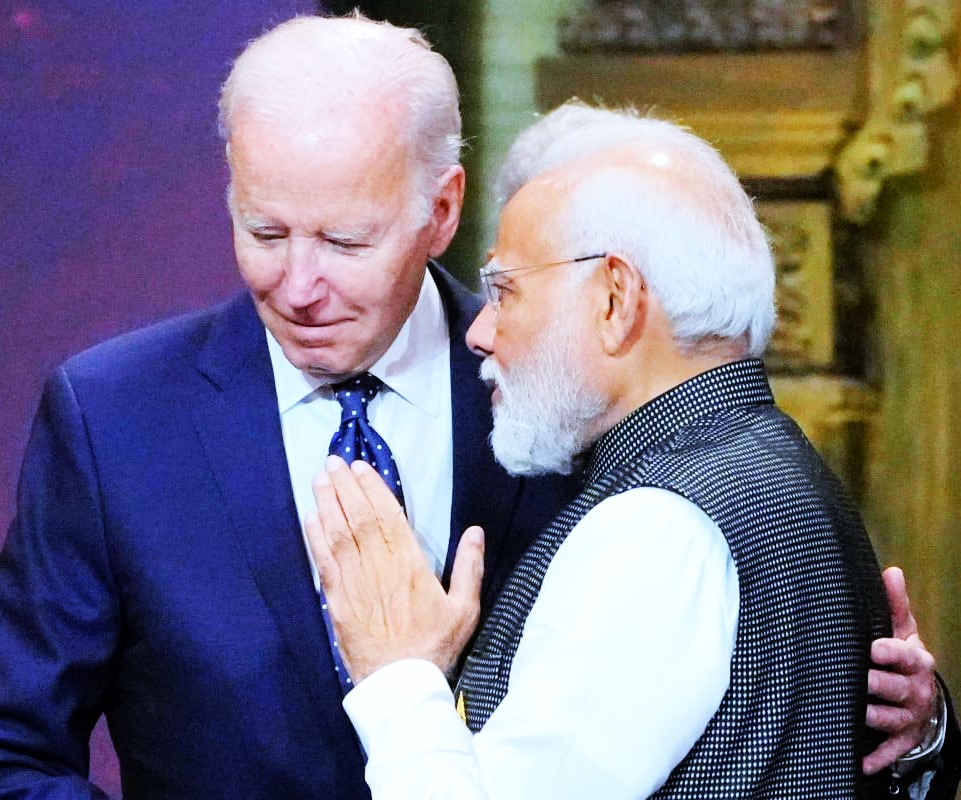
“Charming, but Strange Bedfellows”: US President Joe Biden and India’s Prime Minister Narendra Modi at the G20 leaders’ summit in Bali in November 2022 The humility and charm is Prime Minister Modi’s global Hallmark.
Photo Credit: Associated Press
Popularity of Prime Minister Modi amongst the Indian Diaspora
Prime Minister Narendra Modi enjoys immense popularity among the Indian diaspora living abroad, particularly in the USA and UK. It is worthwhile to explore the reasons for this:
Rockstar-Like Status in the USA:
- Whenever PM Modi travels to foreign nations, he engages in diaspora diplomacy.
- In the USA, he receives a rockstar welcome from the Indian community. During his recent visit, he was greeted with cheers, chants of “Modi, Modi,” and a grand reception.
- Indian-origin individuals’ throng to meet him, take selfies, and express their admiration. The Federation of Indian Associations even flew a 250-feet long banner over the Hudson River in New York to welcome him [20].
- Indian Americans organized Unity Marches in various American cities, celebrating the spirit of unity and chanting patriotic slogans like “Har Har Modi[21],” “Vande Mataram[22],” and “Vande America” [23].
UK and Other Countries:
- PM Modi’s popularity extends beyond the USA. He has perfected the art of filling up huge stadiums and grounds abroad with patriotic fervour.
- Large sections of the Indian diaspora in countries like the UK also admire him.
- His speeches at events attended by the diaspora resonate with pride and enthusiasm, reinforcing their connection to India [24].
Distinguished Role of Indian Diaspora:
- The Indian diaspora represents only 1% of the US population, but its political and economic influence has grown significantly.
- Indian Americans, constituting more than 1.2% of the US population, play an important role, including in American politics [25], [26].
- PM Modi’s outreach to the diaspora strengthens cultural ties, fosters economic collaboration, and reinforces India’s global standing [27].
In summary, Prime Minister Modi’s popularity among the Indian diaspora abroad remains strong, with enthusiastic support from both the USA and the UK.
Modi and South Africans
Prime Minister Narendra Modi has garnered attention and varying levels of popularity among different segments of the population in South Africa, particularly among Africans and people of Indian origin. Let’s explore this further:
Indian Diaspora in South Africa:
- South Africa is home to a significant Indian diaspora, with nearly 1.2 million Indians residing there.
- During the Mandela era, six out of the 16 cabinet members in the South African government were of Indian descent.
- The proportion of Seychelles and Mauritian Indians was notably high, with 70.1% of the population in Mauritius having Indian origins [28].
Modi’s Engagement with the Indian Community:
- Prime Minister Modi has actively engaged with the Indian community in South Africa.
- During his visits, he has mingled with members of the Indian diaspora, fostering a sense of connection and pride.
- His interactions with the community have been well-received, emphasizing the importance of maintaining ties across borders.[29]
Shared Experiences and Identity:
- The Indian diaspora in South Africa shares a history of migration, struggle, and resilience.
- Their experiences, backgrounds, and cultural ties create a sense of longing for their roots.
- While historical amnesia may obscure their African origins, their history intertwines with India, shaping their identity and sense of belonging [30], [31].
Broader Context:
- India’s relations with Africa have evolved over time, and the Modi administration has actively adjusted its African policies.
- Strengthening India–Africa cooperation holds significance for India’s great power confidence and influence in Africa.
- However, challenges such as trade imbalances and mutual trust continue to impact the speed of bilateral relations [32].
In summary, Prime Minister Modi’s popularity resonates differently among Africans and people of Indian origin in South Africa, reflecting a complex interplay of history, culture, and shared experiences.
Modi and Maldives
Since Dr Mohamed Muizzu [33] was elected president of the Maldives in September 2023, a wave of anti-India sentiment has swept the country. President Muizzu has made it clear that his government’s allegiances now lie elsewhere. He boldly stated, “There will be no Indian troops in the country come 10th May 2023. Not in uniform and not in civilian clothing. The Indian military will not be residing in this country in any form of clothing” [34]. This statement came after a spat between the two neighbouring countries, where Muizzu referred to India as a “bully” of smaller countries in the region. In response, India’s Minister of External Affairs, Subrahmanyam Jaishankar [35], pointed out that “big bullies don’t provide $4.5 billion in aid,” alluding to the substantial financial assistance the Maldives still receives from India[36]. Interestingly, President Muizzu’s government recently announced an agreement with China to receive free “military assistance.” China also gifted the Maldives 12 ambulances. This marks the formal establishment of defence ties between the two countries, a move that has surprised many observers. The Maldives, despite being a small archipelago, holds strategic importance due to its location in the Indian Ocean. It lies along a crucial east-west shipping lane that carries all of China’s oil supplies from the Gulf. Additionally, there is a significant US naval base in the vicinity[37]. In contrast, the previous Maldivian government, under President Mohamed Solih, had been more aligned with New Delhi. Over the past five years, India surpassed China as the Maldives’ biggest economic backer, providing funding for hospitals, schools, airports, and other infrastructure projects. However, President Muizzu’s recent actions signal a shift in the country’s foreign policy, raising tensions in the region and challenging India’s influence in the Indian Ocean 1. Despite these developments, India and the Maldives continue to engage in dialogue. Recently, Prime Minister Narendra Modi held a “productive” meeting with President Muizzu on the sidelines of the UN’s COP 28 climate summit, emphasizing the need to deepen their partnership [38]. The relationship between the two nations remains dynamic, influenced by geopolitical factors and strategic interests.
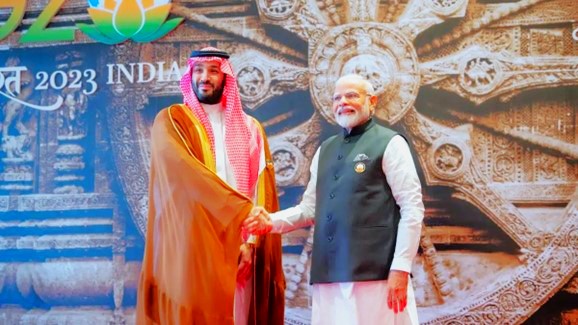
Indian Prime Minister Narendra Modi receives Saudi Arabia’s Crown Prince Mohammed Bin Salman with a warm embrace in Delhi as a host of the 2023 G20 Summit. The two leaders met, exchanged handshakes and a hug at the newly inaugurated Bharat Mandapam convention center in Pragati Maidan.
The Bottom-Line
The Bottom Line is that India, as the world’s most populous nation readies for general elections that begin on 19yh April 2024, politicians face a sobering reality. India is the fastest-growing major economy, but there are still not enough white-collar jobs for its educated youth.[39] Educated and Unemployed: India’s Angry Young Voters
In India, the story of educated yet jobless youth is one of frustration and dashed hopes. As the country gears up for general elections starting on 19th April 2024, politicians confront a stark reality: India boasts the fastest-growing major economy, yet there remains a dearth of white-collar jobs for its educated youth [40].
Some key points:
Demographic Challenge:
- Over half of India’s 1.4 billion people are under the age of 30.
- The potential workforce is expanding demographically, but job opportunities are not keeping pace.
- Many new jobs are in the agricultural sector, which doesn’t align with the aspirations of educated youth [41].
Unemployment Rates:
- The International Labour Organization estimates that 29% of India’s young university graduates were unemployed in 2022.
- This rate is nearly nine times higher than for those without a diploma, who often find work in low-paid service or construction jobs [42].
Government Jobs as a Lifeline:
- For many educated youths, a government job is seen as the ultimate goal.
- These jobs offer stability, benefits, and a path to marriage and family life.
- However, the competition is fierce, with many applicants vying for limited government positions [43].
Migration and Frustration:
- The lack of high-paying private sector jobs drives some to seek opportunities abroad.
- There’s an urge to emigrate illegally, hoping for better prospects in countries like the United States or Canada [44].
Government Efforts and Criticisms:
- Prime Minister Narendra Modi has attracted global tech giants to set up in India, but this success hasn’t translated into the manufacturing jobs that people demand.
- The World Bank warns that India, along with other South Asian nations, is not creating enough jobs to match its growing working-age population[45].
In the midst of economic growth, the plight of educated yet jobless youth remains a pressing issue. As they head to the polls, these young voters carry their frustrations and aspirations, hoping for change that will transform their prospects [46],[47]. In addition, Washington is concerned about India’s ‘slide into illiberalism’, but it ‘doesn’t weaken the US-India ties, much less impact its future trajectory.[48] The US’ concerns arose after India arrested a senior Indian opposition politician and is set to implement a religion-based citizenship law.[49] New Delhi last month summoned a US diplomat to protest Washington’s remarks over the arrest of Delhi Chief Minister Arvind Kejriwal, after a US State Department spokesperson said they were closely following the situation and encouraged a “fair, transparent and timely legal process”. Kejriwal, leader of the opposition Aam Aadmi Party, was arrested on March 21 on allegations of corruption linked to an alleged alcohol excise scam. Several other senior members of his party have also been arrested in relation to the case. India’s Ministry of External Affairs lodged a “strong objection” over the US diplomat’s remarks and chided the US for not being “respectful of the sovereignty and internal affairs of others”. It also rejected US concerns that the implementation of a religion-based citizenship law would be “misplaced, misinformed and unwarranted”, after New Delhi announced on March 11 the rules for the Citizenship Amendment Act[50] and promised its implementation before the country’s coming national elections. These as well as other concerns, are major hurdles which are not only bound to cause major Peace Disruption, but also the new government in India will need to address and overcome, as it enters the election period. The risk of losing international allies are the Bottom Line for Indian Politics in 2024 and beyond. The acid test will be if Modi can maintain his charming popularity, with his charismatic persona.
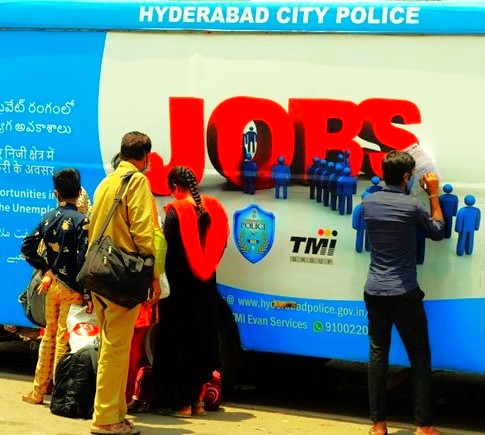
One of the numerous Election Challenges for Prime Minister Modi in the 2024 General Elections in India: Unemployed youths fill application forms to access job openings in the private sector in Hyderabad, India. Photo Credit: AFP
References:
[1] https://en.wikipedia.org/wiki/Jawaharlal_Nehru
[2] Personal quote by author, April 2024
[3] https://www.transcend.org/tms/2024/04/bharatiya-janata-party-pseudo-peace-propagation-in-narendrabhai-damodardas-modis-bharat-hindutva-part-1/
[4] Singh, T. (2023). The Authoritarian Roots of India’s Democracy. Journal of Democracy, 34(3), 133–143
[5] Singh, T. (2023). The Authoritarian Roots of India’s Democracy. Journal of Democracy, 34(3), 133–153
[6] BBC News. (2021, March 15). ‘Electoral autocracy’: The downgrading of India’s democracy
[7] Chhibber, P. (n.d.). Religious Practice and Democracy in India. Cambridge University Press
[8] https://www.transcend.org/tms/2024/01/the-consecration-of-the-new-ram-temple-in-ayodhya-a-glimmer-of-peace-in-a-sea-of-darkness/
[9] https://www.youtube.com/watch?v=_NWzAmwqQYw
[10] https://www.transcend.org/tms/2024/04/bharatiya-janata-party-pseudo-peace-propagation-in-narendrabhai-damodardas-modis-bharat-hindutva-part-1/
[11] http://news.biharprabha.com/2012/08/the-biography-of-sazia-ilmi-a-prominent-team-anna-member/
[12] https://en.wikipedia.org/wiki/Shazia_Ilmi
[13] https://umbc.edu/stories/bollywood-is-playing-a-role-in-indias-elections/
[14] https://www.aljazeera.com/features/2024/3/9/bollywood-take-over-pro-modi-films-swamp-indian-voters-ahead-of-election
[15] https://www.thehindu.com/opinion/editorial/lost-voice-on-indias-abstention-on-the-gaza-vote-at-the-un/article67477119.ece
[16] https://www.indiatoday.in/magazine/india/story/20200817-mood-of-the-nation-pm-modi-still-king-of-indian-politics-with-78-per-cent-approval-rating-1708943-2020-08-07
[17] https://www.pewresearch.org/short-reads/2021/08/05/in-india-hindu-support-for-modis-party-varies-by-region-and-is-tied-to-beliefs-about-diet-and-language/
[18] https://www.pewresearch.org/short-reads/2021/08/05/in-india-hindu-support-for-modis-party-varies-by-region-and-is-tied-to-beliefs-about-diet-and-language/
[19] https://www.newsweek.com/2024/04/19/modis-moment-how-narendra-modi-changing-india-world-1888654.html
[20] https://www.firstpost.com/explainers/pm-narendra-modi-us-popular-indian-americans-diaspora-12768712.html
[21] https://m.youtube.com/playlist?list=OLAK5uy_mSBCKae1HkpqEJFF2CMCn5OlBtqAoDDgc
[22] https://en.wikipedia.org/wiki/Vande_Mataram
[23] https://www.firstpost.com/explainers/pm-narendra-modi-us-popular-indian-americans-diaspora-12768712.html
[24] https://www.outlookindia.com/national/modi-madness-among-indian-diaspora-and-the-west-puts-spotlight-on-india-too-news-233544
[25] https://m.economictimes.com/nri/migrate/indian-diaspora-has-distinguished-itself-across-the-world-pm-modi/articleshow/86447425.cms
[26] https://www.theweek.in/news/world/2021/09/23/indian-diaspora-has-distinguished-itself-across-the-world-modi.html
[27] https://www.channelnewsasia.com/asia/why-india-prime-minister-modi-so-popular-overseas-3586676
[28] https://link.springer.com/chapter/10.1007/978-981-16-4983-7_10
[29] https://apnews.com/general-news-6d740dbbb17e47278e460e1d6e8b18ca
[30] https://journals.ukzn.ac.za/index.php/soa/article/download/732/1148/
[31] https://borderlines-cssaame.org/posts/2021/6/2/india-and-africa-in-parallax
[32] https://link.springer.com/chapter/10.1007/978-981-16-4983-7_10
[33] https://www.aljazeera.com/news/2023/10/1/who-is-mohamed-muizzu-maldivess-pro-china-president-elect
[34] https://www.theguardian.com/world/2024/mar/07/big-bullies-maldives-turns-away-from-india-as-calculating-china-woos-it-with-aid
[35] https://en.wikipedia.org/wiki/S._Jaishankar
[36] https://www.theguardian.com/world/2024/mar/07/big-bullies-maldives-turns-away-from-india-as-calculating-china-woos-it-with-aid
[37] https://www.theguardian.com/world/2024/mar/07/big-bullies-maldives-turns-away-from-india-as-calculating-china-woos-it-with-aid
[38] https://www.thehindu.com/news/national/india-maldives-to-set-up-core-group-to-further-deepen-ties-as-pm-modi-meets-new-maldivian-president-muizzu/article67598378.ece
[39] https://www.msn.com/en-za/news/other/educated-and-unemployed-india-s-angry-young-voters/ar-BB1lu8A3?rc=1&oci
[40] https://www.bing.com/ck/a?!&&p=49f3a48555cfd3b8JmltdHM9MTcxMjg4MDAwMCZpZ3VpZD0wOWJkOGFlOC0zZmI2LTZjZWYtMmI5MS05ZWExM2UyODZkM2MmaW5zaWQ9NzkzMw&ptn=3&ver=2&hsh=3&fclid=09bd8ae8-3fb6-6cef-2b91-9ea13e286d3c&psq=educated+and+unemployed%3a+india%5c%27s+angry+young+voters&u=a1aHR0cHM6Ly93d3cubXNuLmNvbS9lbi16YS9uZXdzL290aGVyL2VkdWNhdGVkLWFuZC11bmVtcGxveWVkLWluZGlhcy1hbmdyeS15b3VuZy12b3RlcnMvYXItQkIxbHU4QTM&ntb=1
[41] https://economictimes.indiatimes.com/jobs/fresher/educated-and-unemployed-indias-angry-young-voters/articleshow/109232851.cms
[42] https://www.newindianexpress.com/nation/2024/Apr/12/indias-rising-voter-demographic-the-agony-of-educated-yet-jobless-youth
[44] https://scroll.in/article/1060710/youth-unemployment-is-a-major-problem-in-india-so-why-is-it-absent-from-national-politics
[45] https://economictimes.indiatimes.com/jobs/fresher/educated-and-unemployed-indias-angry-young-voters/articleshow/109232851.cms
[46] https://www.scmp.com/news/asia/south-asia/article/3258758/educated-jobless-and-angry-indias-young-graduates-drown-despair-even-economy-booms
[47] https://www.msn.com/en-za/news/other/educated-and-unemployed-indias-angry-young-voters/ar-BB1lu8A3
[48] https://www.scmp.com/week-asia/politics/article/3258657/here-stay-us-india-ties-bound-shared-interests-wont-be-marred-recent-incidents-analysts-say?campaign=3258657_70972f9c-f915-11ee-b2bc-02cf01f3e550&module=perpetual_scroll_1_RM&pgtype=article
[49] https://www.voanews.com/a/india-muslims-see-discrimination-in-new-religion-based-citizenship-law/7531377.html#:~:text=Practitioners%20of%20the%20designated%20religions,will%20be%20eligible%20for%20citizenship.
[50] https://www.amnesty.org/en/latest/news/2024/03/india-citizenship-amendment-act-is-a-blow-to-indian-constitutional-values-and-international-standards/#:~:text=The%20CAA%20removes%20barriers%20for,or%20before%2031%20December%202014.
______________________________________________
 Professor G. Hoosen M. Vawda (Bsc; MBChB; PhD.Wits) is a member of the TRANSCEND Network for Peace Development Environment.
Professor G. Hoosen M. Vawda (Bsc; MBChB; PhD.Wits) is a member of the TRANSCEND Network for Peace Development Environment.
Director: Glastonbury Medical Research Centre; Community Health and Indigent Programme Services; Body Donor Foundation SA.
Principal Investigator: Multinational Clinical Trials
Consultant: Medical and General Research Ethics; Internal Medicine and Clinical Psychiatry:UKZN, Nelson R. Mandela School of Medicine
Executive Member: Inter Religious Council KZN SA
Public Liaison: Medical Misadventures
Activism: Justice for All
Email: vawda@ukzn.ac.za
Tags: Biden, Elections, Hindus, India, Muslims, Narendra Modi, Politics, Trump, USA
This article originally appeared on Transcend Media Service (TMS) on 15 Apr 2024.
Anticopyright: Editorials and articles originated on TMS may be freely reprinted, disseminated, translated and used as background material, provided an acknowledgement and link to the source, TMS: Elections in Narendrabhai Damodardas Modi’s Bharat Hindutva: A Lesson in the Transformation of Democracy in Religious Autocracy (Part 2), is included. Thank you.
If you enjoyed this article, please donate to TMS to join the growing list of TMS Supporters.

This work is licensed under a CC BY-NC 4.0 License.
Dear Professor Rosa,
I hope this message finds you well.
I am writing to follow up on a recent submission I sent to TMS from my Gmail account. Due to technical issues, my UKZN email is currently non-functional, but I anticipate it will be restored in the coming days.
Over the past months, I experienced a severe health setback, having been hospitalized for ten months due to Guillain-Barré Syndrome, which necessitated intensive care and mechanical ventilation. This unforeseen circumstance rendered me unable to communicate during that period.
Given my long-standing affiliation with TMS and my commitment to our shared mission, I am eager to continue contributing. I would appreciate any updates regarding my recent submission and any guidance on how to proceed with future contributions, especially during this interim period while my institutional email is being restored.
Thank you for your understanding and continued support.
Warm regards,
Professor Hoosen Vawda
Mobile: + 2782 291 4546 / +27 83 625 7266